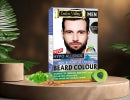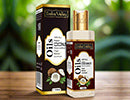Short Summary Of The Blog
We always place a high priority on healthy hair, no matter what our beauty goals are. We don't want to experiment too much to the point that it compromises our hair health. That's why we are always seeking out the best natural hair colour. There are so many reasons why people colour their hair today. While covering greys may be the primary reason, it is not the only one.
Ingredients in natural hair dye should not have the ability to harm your hair. The best hair dye won't contain dangerous substances like ammonia, PPD, hydrogen peroxide (bleach), or other heavy metals that tend to damage hair's texture and result in hair breakage.
What Are the Effects of Chemicals on Hair?
1. Ammonia - By opening it up, it allows bleach and colourants to penetrate the hair's outer layer. As a result, hair strands lose their natural oil, becoming dry and brittle. The hair strands are never penetrated by natural organic hair colours. They can only colour hair by covering them from the outside.
2. Hydrogen Peroxide - When hydrogen peroxide (bleach), a component of chemical hair colours, enters the hair strands, it starts to eat away at the melanin that gives the hair its natural colour, leaving the hair completely colourless. A chemical reaction between it and PPD then fills in the new colours. Regular use of this eventually inhibits the creation of all melanin, leaving hair permanently white.
3. PPD - The primary component of chemical hair dyes is what creates the new colour effects. It works in conjunction with hydrogen peroxide. In those with sensitive skin, it can result in a variety of skin irritations and potentially lethal allergies.
Why Should You Choose an Ammonia Free Hair Colour?
1. Chemical side effects are not associated with Ammonia Free Hair colours, since they do not contain artificial chemicals. Herbs in this hair care product nourish the hair and scalp from the inside out, keeping the hair lustrous, healthy, and strong.
2. An ammonia free hair colour should also be at the top of your priority list due to its stunning colouration and inherent impermanence. The semi-permanent colouring effects of naturally natural hair colouring might persist for four to six weeks.So, every other month, you have more opportunities to experiment with colours and hair styling techniques. Damage-Free Hair Colours leave sombre, natural hues that can be as stunning as that of any chemical hair colour.
3. It also promotes hair growth and contributes to hair health. Natural ingredients provide not just one benefit, but a multitude of other side benefits, such as conditioning, hydrating, and nourishing scalp and hair for their future health maintenance.
4. Additionally, a lot of us might have previously damaged our hair by regular heat treatments and chemical treatments like smoothening, re-bonding, curling, or colouring. Chemicals tend to age hair faster, so we should avoid using them on our hair at all costs. This makes it all the more important to use a damage-free hair colour. A natural hair colour with a combination of hair colouring herbs will not only color your hair red, but will give you a variety of natural hair colours.
Which is the Best Damage Free Hair Colour Available in the Market?
One of the top natural hair colours currently available on the market, according to users, is Indus Valley Damage Free Gel Hair Colours, which are available in 6 tones. It encourages healthy, luscious hair by colouring hair without causing damage. It also helps protect the hair and scalp from the sun's harmful UV rays, smog, and dust.
The eight organic herb extracts that assist make hair stronger, healthier, and well-nourished include henna, amla, aloe vera, jojoba, orange, sunflower, wheatgerm, and basil.
The Takeaways From this Discussion-
- It would be better if you experimented with an organically natural damage-free hair colour rather than using hair colours that are chemically based, especially if you are just starting out with hair colouring.
- Always perform a patch test 48 hours before to colouring your hair to determine whether you are sensitive to pollen or vegetables.
Do you have any further inquiries about this? If you are experiencing issues with your hair or scalp, don't hesitate to speak with our health and beauty experts.
Frequently Asked Questions
1. What is natural hair colour?
Natural hair colour uses plant-based ingredients and herbal extracts to colour hair gently without damaging the hair shaft or scalp.
2. Why should I avoid chemical hair dyes?
Chemical dyes often contain ammonia, bleach, and PPD, which can dry hair, cause breakage, irritate the scalp, and lead to long-term hair damage.
3. How does ammonia affect hair?
Ammonia opens the hair cuticle, allowing chemicals to penetrate deeply, which strips natural oils and makes hair dry, brittle, and weak over time.
4. Is ammonia-free hair colour better for hair health?
Yes. Ammonia-free hair colours are gentler, reduce scalp irritation, and help maintain moisture while providing natural-looking colour results.
5. Can natural hair colour cover grey hair effectively?
Yes. Damage-free natural hair colours can provide good grey coverage while nourishing hair and maintaining its strength and texture.
6. How long does natural hair colour last?
Most natural or semi-permanent hair colours last between four to six weeks, allowing safe and flexible colour experimentation.
7. Is natural hair colour suitable for damaged or treated hair?
Yes. Natural hair colours are ideal for hair that has undergone heat styling or chemical treatments, as they help repair and nourish hair.
8. Why is a patch test important before using hair colour?
A patch test helps identify possible sensitivities or allergies, ensuring safe application and preventing unwanted skin reactions.








































































